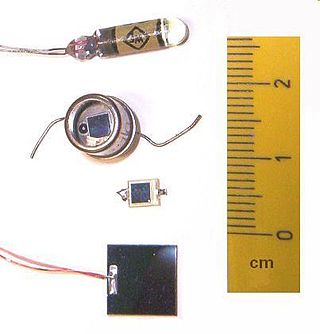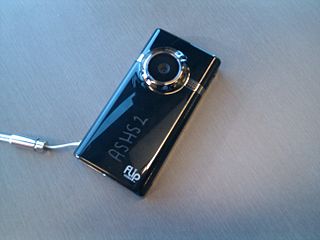Related Research Articles

A charge-coupled device (CCD) is an integrated circuit containing an array of linked, or coupled, capacitors. Under the control of an external circuit, each capacitor can transfer its electric charge to a neighboring capacitor. CCD sensors are a major technology used in digital imaging.

A photodiode is a semiconductor diode sensitive to photon radiation, such as visible light, infrared or ultraviolet radiation, X-rays and gamma rays. Photodiode is a PN semiconductor material that produces current or voltage Photovoltaics when it absorbs photons Semiconductor Optoelectronics . The physics of electron excitation for photodiodes are similar to Photoconductivity typically implemented as a Photoresistor or as switches in Thyristor#Photothyristors. Photodiodes can be used for detection and measurement applications, or optimized for the generation of electrical power in solar cells. Photodiodes are used in a wide range of applications throughout the electromagnetic spectrum from IR, visible light, UV photocells to gamma ray spectrometers.
Digital image processing is the use of a digital computer to process digital images through an algorithm. As a subcategory or field of digital signal processing, digital image processing has many advantages over analog image processing. It allows a much wider range of algorithms to be applied to the input data and can avoid problems such as the build-up of noise and distortion during processing. Since images are defined over two dimensions digital image processing may be modeled in the form of multidimensional systems. The generation and development of digital image processing are mainly affected by three factors: first, the development of computers; second, the development of mathematics ; third, the demand for a wide range of applications in environment, agriculture, military, industry and medical science has increased.

A sensor is a device that produces an output signal for the purpose of detecting a physical phenomenon.
LBCAST is a type of photo sensor which the manufacturer claims is simpler and thus smaller and faster than CMOS sensors. It was developed over ten years by Nikon, in parallel with other manufacturer's development of CMOS, and resulted in shipping product in 2003.
Digital imaging or digital image acquisition is the creation of a digital representation of the visual characteristics of an object, such as a physical scene or the interior structure of an object. The term is often assumed to imply or include the processing, compression, storage, printing and display of such images. A key advantage of a digital image, versus an analog image such as a film photograph, is the ability to digitally propagate copies of the original subject indefinitely without any loss of image quality.

A video camera is an optical instrument that captures videos, as opposed to a movie camera, which records images on film. Video cameras were initially developed for the television industry but have since become widely used for a variety of other purposes.
A digital image is an image composed of picture elements, also known as pixels, each with finite, discrete quantities of numeric representation for its intensity or gray level that is an output from its two-dimensional functions fed as input by its spatial coordinates denoted with x, y on the x-axis and y-axis, respectively. Depending on whether the image resolution is fixed, it may be of vector or raster type. By itself, the term "digital image" usually refers to raster images or bitmapped images.

Photodetectors, also called photosensors, are sensors of light or other electromagnetic radiation. There are a wide variety of photodetectors which may be classified by mechanism of detection, such as photoelectric or photochemical effects, or by various performance metrics, such as spectral response. Semiconductor-based photodetectors typically use a p–n junction that converts photons into charge. The absorbed photons make electron–hole pairs in the depletion region. Photodiodes and photo transistors are a few examples of photo detectors. Solar cells convert some of the light energy absorbed into electrical energy.
In photography, shutter lag is the delay between triggering the shutter and when the photograph is actually recorded. This is a common problem in the photography of fast-moving objects or animals and people in motion. The term narrowly refers only to shutter effects, but more broadly refers to all lag between when the shutter button is pressed and when the photo is taken, including metering and focus lag.

An image sensor or imager is a sensor that detects and conveys information used to form an image. It does so by converting the variable attenuation of light waves into signals, small bursts of current that convey the information. The waves can be light or other electromagnetic radiation. Image sensors are used in electronic imaging devices of both analog and digital types, which include digital cameras, camera modules, camera phones, optical mouse devices, medical imaging equipment, night vision equipment such as thermal imaging devices, radar, sonar, and others. As technology changes, electronic and digital imaging tends to replace chemical and analog imaging.
The J. J. Ebers Award was established in 1971 to foster progress in electron devices. It commemorates Jewell James Ebers, whose contributions, particularly to transistors, shaped the understanding and technology of electron devices. It is presented annually to one or more individuals who have made either a single or a series of contributions of recognized scientific, economic, or social significance in the broad field of electron devices. The recipient is awarded a certificate and check for $5,000, presented at the International Electron Devices Meeting.

An active-pixel sensor (APS) is an image sensor, which was invented by Peter J.W. Noble in 1968, where each pixel sensor unit cell has a photodetector and one or more active transistors. In a metal–oxide–semiconductor (MOS) active-pixel sensor, MOS field-effect transistors (MOSFETs) are used as amplifiers. There are different types of APS, including the early NMOS APS and the now much more common complementary MOS (CMOS) APS, also known as the CMOS sensor. CMOS sensors are used in digital camera technologies such as cell phone cameras, web cameras, most modern digital pocket cameras, most digital single-lens reflex cameras (DSLRs), mirrorless interchangeable-lens cameras (MILCs), and lensless imaging for cells.

In digital photography, the image sensor format is the shape and size of the image sensor.
Michael Tompsett is a British-born physicist, engineer, and inventor, and the founder director of the US software company TheraManager. He is a former researcher at the English Electric Valve Company, who later moved to Bell Labs in the United States. Tompsett invented CCD imagers and designed and built the first ever video camera with a solid-state (CCD) sensor. Tompsett received the Queen Elizabeth Prize for Engineering in 2017, with Eric Fossum, George Smith, and Nobukazu Teranishi. Tompsett has also received two other lifetime awards; the New Jersey Inventors Hall of Fame 2010 Pioneer Award, and the 2012 IEEE Edison Medal. The thermal-imaging camera tube developed from his invention also earned a Queen's Award in 1987.

A back-illuminated sensor, also known as backside illumination (BI) sensor, is a type of digital image sensor that uses a novel arrangement of the imaging elements to increase the amount of light captured and thereby improve low-light performance.
Nobukazu Teranishi is a Japanese engineer who researches image sensors, and is known for inventing the pinned photodiode, an important component of modern digital cameras. He was one of four recipients of the 2017 Queen Elizabeth Prize for Engineering. His industrial career wasa at NEC Corporation (1978–2000) and Panasonic Corporation (2000–13). As of 2018, he is a professor at the University of Hyogo and at Shizuoka University.
sCMOS are a type of CMOS image sensor (CIS). These sensors are commonly used as components in specific observational scientific instruments, such as microscopes and telescopes. sCMOS image sensors offer extremely low noise, rapid frame rates, wide dynamic range, high quantum efficiency, high resolution, and a large field of view simultaneously in one image.
Orly Yadid-Pecht is a Professor of Electrical and Software Engineering and Alberta Innovates Technology Futures Strategic Chair of Integrated Intelligent Sensors at the University of Calgary. She develops CMOS based imaging devices for biomedical sensing. She is a Fellow of the Institute of Electrical and Electronics Engineers, SPIE and American Institute for Medical and Biological Engineering. She is an ASTech Award Winner for Technology. Yadid-Pecht holds several patents for new technologies, including sensors, health monitoring devices and drug delivery systems.
References
- ↑ B. Stern, Inventors at Work, Apress 2012.
- ↑ "Eric R. Fossum '79, H'14".
- 1 2 "Eric R. Fossum" (PDF).
- ↑ "Trinity Fire Fighting Robot Contest -Event Sponsors". Archived from the original on 2014-01-30. Retrieved 2007-09-11.
- ↑ Fossum, E. R. (1 September 2013). "Modeling the Performance of Single-Bit and Multi-Bit Quanta Image Sensors". IEEE Journal of the Electron Devices Society. 1 (9): 166–174. CiteSeerX 10.1.1.646.5176 . doi:10.1109/JEDS.2013.2284054. S2CID 14510385.
- ↑ Engineering, Thayer School of. "PhD Innovation Program - Thayer School of Engineering at Dartmouth". engineering.dartmouth.edu.
- ↑ B. Stern, Inventors at Work, Apress 2012.
- ↑ e.g. US Patents 5,471,515 and 5,841,126
- ↑ Fossum, Eric R. (12 July 1993). Blouke, Morley M. (ed.). "Active pixel sensors: are CCDs dinosaurs?". SPIE Proceedings Vol. 1900: Charge-Coupled Devices and Solid State Optical Sensors III. Charge-Coupled Devices and Solid State Optical Sensors III. 1900. International Society for Optics and Photonics: 2–14. Bibcode:1993SPIE.1900....2F. CiteSeerX 10.1.1.408.6558 . doi:10.1117/12.148585. S2CID 10556755.
- 1 2 Fossum, Eric R.; Hondongwa, D. B. (2014). "A Review of the Pinned Photodiode for CCD and CMOS Image Sensors". IEEE Journal of the Electron Devices Society. 2 (3): 33–43. doi: 10.1109/JEDS.2014.2306412 .
- ↑ "Engineering alum Eric Fossum wins Queen Elizabeth Prize for Engineering". YaleNews. January 29, 2018. Retrieved January 29, 2018.
- ↑ "Photobit Corporation". www.twst.com.
- ↑ cite web|url=https://image-sensors-world.blogspot.com/2007/09/eric-fossum-left-siimpel.html
- ↑ cite web|url=https://www.socaltech.com/Siimpel_Acquired_By_Tessera/s-0028417.html
- ↑ "International Image Sensor Society". www.imagesensors.org.
- ↑ "United States SEC Database". www.secdatabase.com.
- ↑ "Berkshire Hathaway Press Release". www.businesswire.com.
- ↑ "Eric R. Fossum". Dartmouth Engineering. Retrieved 18 February 2024.
- ↑ See Google Scholar
- ↑ USPTO Search 2020
- ↑ "PSA Progress Medal".
- ↑ "Royal Photographic Society". www.rps.org.
- ↑ "Inductee Detail - National Inventors Hall of Fame".
- ↑ "National Academy of Inventors". www.academyofinventors.org. Archived from the original on 2013-01-28. Retrieved 2014-08-08.
- ↑ "National Academy of Engineering Elects 69 Members And 11 Foreign Associates".
- ↑ Webmaster. "Six Honorary Degrees to be Awarded at Commencement". www.trincoll.edu.
- ↑ "2017 QEPrize Winners - Queen Elizabeth Prize for Engineering".
- ↑ "Edwin H. Land Medal". The Optical Society.